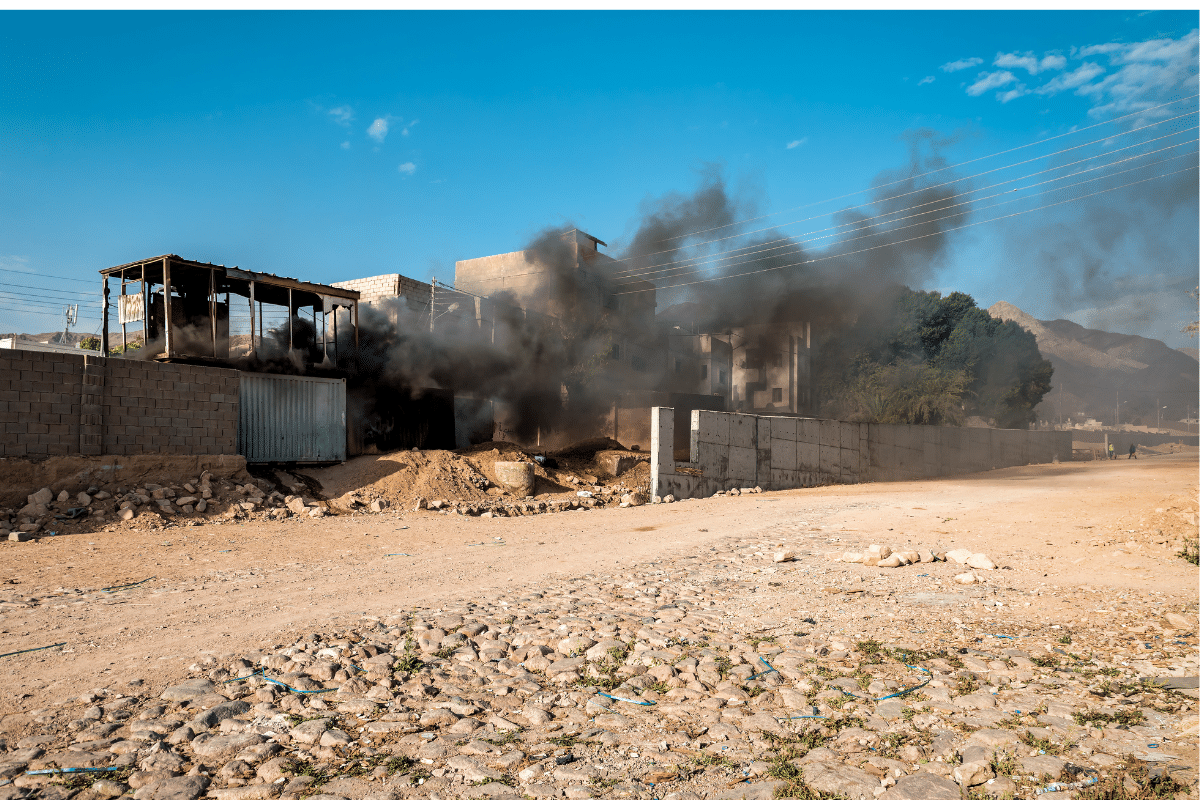
A disturbing practice prevailed in the bases established for America’s post-9/11 wars: military waste was routinely incinerated in vast open air lots on the outskirts of overseas outposts, creating health problems for Veterans from burn pit exposures.
These burn pits, some of which burned incessantly for years, served as receptacles for discarded items ranging from computers and furniture to medical waste. The resulting plumes of toxic smoke and particles permeated the air, posing a health hazard to military personnel and civilians.
As time passed, the connection between exposure to these toxins and the illnesses afflicting numerous former service members became increasingly evident. Recognizing the urgency to address this issue, President Biden took a significant step forward by signing the VA PACT Act into law, expanding medical benefits for affected veterans.
The VA PACT Act, short for “Protecting Our American Heroes from Chemical Toxicity,” aims to provide much-needed support to veterans grappling with respiratory ailments, cancer, and other diseases likely caused by their exposure to the harmful toxins released by trash fires on combat outposts in countries such as Afghanistan, Iraq, Syria, and beyond.
This article will give you a comprehensive understanding of burn pit exposures. You will explore their origins, examine the locations where they occur, and shed light on the adverse health conditions associated with them.
What is a Burn Pit?
As their name suggests, burn pits served as designated areas where the U.S. military disposed of on-site waste during deployments. These burn pits varied in size, ranging from the dimensions of football fields to sprawling expanses spanning several acres of open land.
At first glance, a burn pit may seem innocuous – just a pit where waste is burned but the range of materials incinerated within these burn pits was extensive and included substances such as:
- Aluminum cans
- Chemicals
- Food
- Metal
- Paint
- Plastics
- Rubber
- Wood
- As well as medical and human waste
As the flames consumed these diverse materials, they emitted toxic fumes and pollutants that adversely affected service personnel. One concerning aspect is that the impact of burn pit exposure may not manifest immediately, making it challenging for veterans to connect their long-term health issues to their time spent near burn pits in Iraq and Afghanistan. Consequently, veterans may be unaware that their current health struggles are linked to their past exposure to these burn pits.
The consequences of burn pit exposures manifested in various negative health conditions, silently waging a battle within the bodies of affected veterans. Respiratory problems and lung diseases became prevalent as toxic fumes scarred their airways, leading to debilitating conditions. Skin disorders and allergies plagued others, leaving them with constant discomfort and irritation. Gastrointestinal disorders became a daily struggle, with digestive systems bearing the burden of ingesting contaminated food and water.
Locations and Scope of Toxic Exposure
As our troops served in conflict zones and military bases, they unwittingly breathed in the toxic emissions from the burn pits. The prevalence of burn pits was extensive, from Bagram Airfield in Afghanistan, Camp Victory in Iraq, and many others served as ticking time bombs, endangering the health of countless service members. The toxic exposures endured by those stationed near these burn pits created many health risks, haunting them long after their service ended.
The potential health effects of burn pit exposure can vary depending on several factors, with those closest suffering the harshest consequences. These factors are crucial in determining the degree of risk for both short-term and long-term health consequences. Key factors to consider include:
| Factors | Description |
|---|---|
| Types of Waste burned | The specific materials incinerated in the burn pits can influence the potential health hazards. |
| Proximity, duration, and frequency | The proximity to the burn pit, the amount of time spent nearby, and the frequency of exposure. |
| Wind direction and weather-related | The direction of the wind and other weather conditions can impact the dispersion of toxic fumes. |
| Presence of other airborne/environmental | Additional pollutants or hazards in the surrounding area can compound health risks. |
Considering these factors is crucial in assessing the potential health implications for individuals exposed to burn pits. It underscores the importance of thorough evaluation and monitoring to address any adverse health effects that may arise from such exposures.
Burn Pit Presumptive List
The presumption process involves two steps. Firstly, veterans who served in specific areas during particular periods are presumed to have been exposed to burn pits. Once the exposure is presumed, certain conditions are then presumptively connected.
The locations that give rise to a presumption of burn pit exposure include:
On or after August 2, 1990:
- Bahrain
- Iraq
- Kuwait
- Oman
- Qatar
- Saudi Arabia
- Somalia
- The United Arab Emirates (UAE)
- The airspace over these areas
On or after September 11, 2001:
- Afghanistan
- Djibouti
- Egypt
- Jordan
- Lebanon
- Syria
- Uzbekistan
- Yemen
- The airspace over these areas
The conditions presumed to be connected to burn pit exposure include:
- Asthma diagnosed after service
- Head cancer of any type
- Neck cancer of any type
- Respiratory cancer of any type
- Gastrointestinal cancer of any type
- Reproductive cancer of any type
- Lymphoma cancer of any type
- Lymphatic cancer of any type
- Kidney cancer
- Brain cancer
- Melanoma
- Pancreatic cancer
- Chronic bronchitis
- Chronic obstructive pulmonary disease (COPD)
- Constrictive bronchiolitis or obliterative bronchiolitis
- Emphysema
- Granulomatous disease
- Interstitial lung disease
- Pleuritis
- Pulmonary fibrosis
- Sarcoidosis
- Chronic sinusitis
- Chronic rhinitis
- Glioblastoma
This list may expand as research into the effects of burn pit exposure continues.
VA Burn Pit Registry
To better understand the extent of burn pit exposures and their long-term effects, the Burn Pit Registry was created. This registry is a voluntary tool that helps Servicemembers and Veterans become more aware of their health and assists the Department of Veterans Affairs (VA) identify potential health conditions linked to burn pit exposure or other airborne hazards during military service.
By documenting their experiences and health conditions, the registry aids in identifying trends, conducting research, and developing appropriate medical treatments. It also plays a vital role in advocating for increased support and resources for affected veterans. Participation in the registry is voluntary.
VA Benefits for Toxic Exposure
Veterans can apply for benefits using available VA forms or seek assistance from a Va accredited law group like VetsForever or a Veterans Service Organization (VSO). It is recommended that veterans check the accreditation of an organization or individual through VA’s website. Filing a claim can make veterans eligible for immediate care, and experts advise veterans and survivors to apply as soon as possible to start the claims process.
This is especially important for surviving spouses, who have the opportunity to backdate claims to the original denial date. Michael Figlioli, the national veterans’ services director for Veterans of Foreign Wars, describes the PACT Act as one of the most significant pieces of veteran-friendly legislation, urging eligible individuals to take advantage of this opportunity and apply immediately.
Are survivors eligible for benefits under the PACT Act?
Yes! The PACT Act extends benefits to survivors as well. The PACT Act broadens the range of presumptive conditions related to toxic exposures, incorporating 23 additional conditions that the VA acknowledges for post-9/11 veterans exposed to burn pits. This includes 11 respiratory diseases and various forms of cancer.
Survivors of veterans who were denied VA coverage for a service-connected disability due to burning pit exposure and whose conditions or service locations have now been included in the expanded list can apply for benefits retrospectively, even after the veteran’s passing. These benefits include:
| Benefits | Eligibility |
|---|---|
| Monthly VA Dependency and Indemnity Compensation (VA DIC) | Spouses, dependent children, or parents |
| One-time accrued benefits payment | Spouses, dependent children, or dependent parents |
| Monthly Survivors Pension | Spouses and dependent children |
| Other benefits | Based on the deceased veteran’s service record and current family income status, including burial insurance, job training, or favorable home loan programs |
VA Toxic Exposure Rating
The VA utilizes the rating schedule to assign a rating for each claimed condition associated with burn pit exposure. If a veteran seeks VA disability compensation benefits for a respiratory or other health condition, the VA will apply the specific rating schedule. In essence, the rating for burn pits is determined by the severity of symptoms that can be demonstrated to have worsened or directly resulted from exposure.
The corresponding condition’s rating criteria will be examined, ranging from 10% to 100%. Veterans with a 100% disability rating can receive over $3,000 monthly. It is worth noting that, in recent years, the VA’s recognition of illnesses related to toxic exposure in Iraq and Afghanistan has evolved after years of non-recognition.
Summary
In conclusion, the truth about burn pit exposures is a sobering revelation. Our brave men and women in uniform, who selflessly sacrificed for our country, now suffer the consequences of the toxic exposures they endured during their service. We must shed light on this issue and take action to support and advocate for affected veterans.
By understanding what burn pits are and how they became a source of toxic exposure, we can comprehend the gravity of the situation. Examining the locations and scope of toxic exposure reinforces the urgency of addressing this widespread issue. The harmful health conditions experienced by veterans demand our attention and care. The recognition provided by the Burn Pit Presumptive List, alongside the documentation facilitated by the Burn Pit Registry, are crucial steps toward justice and assistance for those affected.

